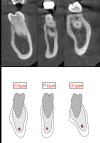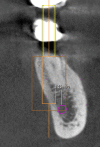Prosthetically driven immediate implant placement at lower molar area; an anatomical study
- PMID: 32518907
- PMCID: PMC7252531
- DOI: 10.26650/eor.20200059
Prosthetically driven immediate implant placement at lower molar area; an anatomical study
Abstract
Purpose: To examine the effectiveness and safety of immediate implant placement (IIP), we evaluated the risk of lingual plate perforation (LPP) and mandibular canal perforation (MCP) associated with posterior mandible anatomy using cone beam computed tomography (CBCT) images.
Materials and methods: A morphological study of the molar sockets of 135 patients (age: 18-84 y) was done and its relationship to the mandibular canal was investigated. The risk of LPP and MCP was recorded as yes or no. Mandibular cross-sectional morphology was defined as one of three types (U-P-C) using the criteria of Chan et al.
Results: The risk of LPP was significantly higher for second molars (p = 0.0001), and the risk increased with age (p = 0.039). There was a strong relationship between the risk of LPP and cross-section type U (p = 0.0001). The mean root to alveolar canal (RAC) distance (mm) of males was significantly higher than that of females. The mean RAC value was 5.02 mm for males and 3.49 mm for females. There was no statistically significant relationship between the risk of MCP and sex. There was a significant relationship between the risk of MCP and cross-section type U (p = 0.0001). Although the MCP risk was higher in second molars, there was no statistically meaningful relation between MCP and tooth type.
Conclusion: The results suggest that IIP in the mandibular molar area carries a high risk of MCP and LPP. Based on the elevated level of risk, a delayed implant protocol should be considered.
Keywords: CBCT;; immediate implant; lingual plate perforation; mandible; mandibular canal.
Copyright © 2020 European Oral Research.
Figures




References
LinkOut - more resources
Full Text Sources
Miscellaneous
